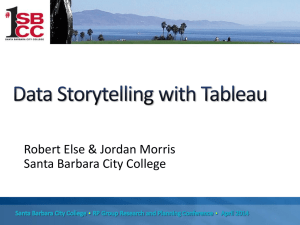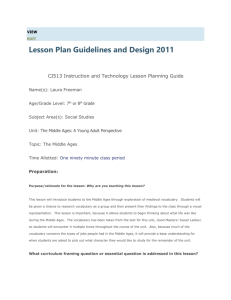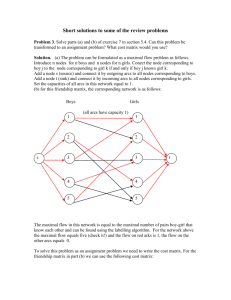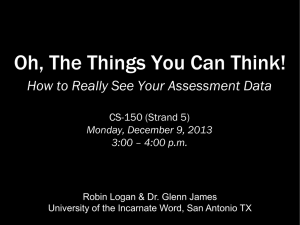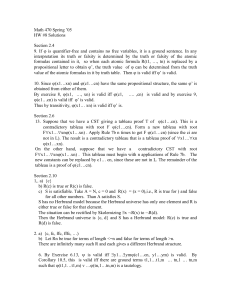Solution Middle Ages Vocabulary
advertisement
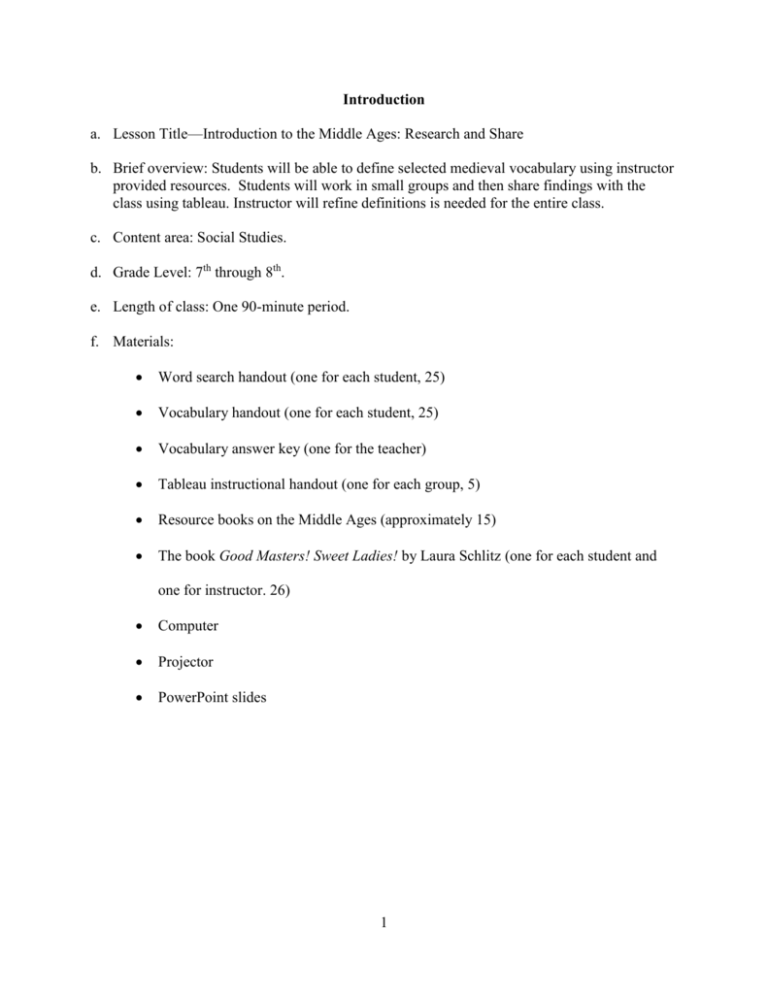
Introduction a. Lesson Title—Introduction to the Middle Ages: Research and Share b. Brief overview: Students will be able to define selected medieval vocabulary using instructor provided resources. Students will work in small groups and then share findings with the class using tableau. Instructor will refine definitions is needed for the entire class. c. Content area: Social Studies. d. Grade Level: 7th through 8th. e. Length of class: One 90-minute period. f. Materials: Word search handout (one for each student, 25) Vocabulary handout (one for each student, 25) Vocabulary answer key (one for the teacher) Tableau instructional handout (one for each group, 5) Resource books on the Middle Ages (approximately 15) The book Good Masters! Sweet Ladies! by Laura Schlitz (one for each student and one for instructor. 26) Computer Projector PowerPoint slides 1 Lesson Script g. Detailed sequence/timing Intro/Look Back: 1. (5 minutes). T: Welcome good masters and sweet ladies! Last week we saw the fall of the mighty Roman Empire, and now we will be moving on to Europe’s Middle Ages. Specifically, we are going to examine what daily life was like in a medieval village. Our studies will center on Laura Amy Schlitz’s book “Good Masters! Sweet Ladies!,” but before you are given the text, and learn a little more about it, we are going to start with an activity. Through 2. (10 Minutes). Pass out word search. Allow ten minutes for students to find the vocabulary. At the end of ten minutes tell students it is alright if they have not found all the words, and they can always continue searching if they have any free time later. If time, teacher can ask student how many of them managed to find more than five, ten, fifteen, etc., by a show of hands. 3. (5 Minutes). Divide the class into five groups; each group will have five members. This will be done by going around the classroom and numbering students one through five. 4. (5 Minutes). Divide the vocabulary from the word search among the groups. One group will only be responsible for three words. Pass out pile of books to students; each group will have three or four sources to use for finding answers. Teacher will have already gone through sources and make sure words can be found in books. The words they research depend on what stack of books they receive. 2 a. T: As a group, I want you to come up with definitions for the each of the words you are responsible for finding. Write the words along with the definitions down on a piece of paper. This paper will be handed to the instructor, so make sure it is legible. Once you have found all the definitions, please raise your hand and I will come and collect the group paper. We will then be shifting into one of the class’s favorite activities—tableau. 5. (35 Minutes). Allows students to research. Teacher will walk around the room to make sure that students are staying on track. Teacher will also make sure to answer any questions and provide guidance and hints if needed. a. Possible leading questions: i. Have you already checked the index? ii. Some books have a glossary? iii. What can the chapter titles tell you? iv. Browse through the pictures, do any of them seem to be related to the word you are trying to find? When each group finishes, instructor will take definitions and give tableau handout. Students will be asked to think about what word they would like to represent through a tableau. 6. (5 minutes). Teacher gets the attention of the entire class. T: It appears that everyone has finished with their research. Great job and thank you for staying on task. Your group is now in charge of using one vocabulary word to create a tableau. We all have done tableaus in the past, but I have handed out a reminder of key points to consider while composing your tableau. You have five minutes to work before sharing with the class. 3 7. (15 minutes). Students are asked to share their tableau with the rest of the class. Each group has told the instructor the word they will be using, and the instructor puts the definition and the word on a PowerPoint slide while the students are preparing to share their tableau. During each tableau the instructor asks the viewing students: a. What is going on in the scene? b. Are different levels being used? c. What is the focal point? d. Are the students displaying strong emotions? e. Is there any tension between tableau characters? f. What do you think the word might be? At the end of each tableau the instructor will display the word and definition on the projector using the PowerPoint slides. Beyond 8. (10 minutes). Hand out texts. T: Thank you for sharing your creative and entertaining tableaus. The vocabulary you have been using was not randomly selected, but was taken from your text for this unit. We will be using Good Masters! Sweet Ladies! by Laura Amy Schlitz. Ms. Schlitz is a librarian, playwright , and storyteller who created this book of medieval monologues for her school when she saw that there was nothing like it available. I am now going to read you a list of the characters and a short description of each, and your exit slip today will be the top three stories you are interested in working with for this unit. At the start of the next class I will also hand you a paper with all of the definitions, and we will have a short review. a. Short descriptions found on the back of Good Masters! Sweet Ladies! 4 h. Sample handouts. Middle Ages Vocabulary G N I B M A L N C L F P D P M R W Y I A M P N O Q L I Z M Z E L S L J D E W J Y A Y V P Z E N J N Q X N L O K X X W K B R P V N L N I M V K E X T W T Q N J H T E K P L P P J J D C A C R B Y Z Z R K Q N W I R S A C F A W H I C O P E X O L F O V Z C E R M R F M L I C Y D C Q E L G C N C Z U N A W O L L A F M A N O R Q L L M I S N S T M B E F I S H M O N G E R A Z A H Z S K I R D Y C G B K E U Q D B F D P V V R E W C N T U T Q V G G O M S APPRENTICE CRUSADE FALCONER FALLOW FEUDAL FISHMONGER LAMBING MANOR MAYLING MILLER PILGRIM PLOWBOY POTTAGE RELIC SARACENS SNIGGLER TANNER VARLET VILLEIN E Z X F Q W R G K E L A Q D P A F G D O J E X S G J T E I E N A D D H T T O M K V P I L G R I M L N M G D I W T S G I R O A T G P I B Q E G S A I U U O V R L L U Y R T Q B X R G A G V Y A E P R F L T H T H L E G D J F J J I Q L X F C W E X E K I G E U O C N L P A N N I I K Y R C L R H L T T S E H S O V C S C N V Z L T H C R T Y M V D M P E M A Y J F G O J Q Created through: http://www.discoveryeducation.com 5 Solution Middle Ages Vocabulary G N I B M A L N + + + + + P + + + + + + + + + + + + I + + + + + S L + + + + + + A + + + + E + + + + + N + O + + + + + + R P + + L + + + + + E + + W + + + + + + E + P L + + + + + C + + + B + + + + + + N + I R + + C + A + + + C O + + + + + + O V + + E R + R + + + I + Y + + + + + + C + + + U N A W O L L A F M A N O R + + L + + S + S T + + E F I S H M O N G E R A + A + + + + I R + + + + + + E + + + + F D + + + + + + C + + + T + + G + + + + E + + + + + R + + E L A + + + A + + + + + + + + + + + E + + N A + + + T + + M + V P I L G R I M L N M + D + + T + + I + + A + + + + + + E G + A + U + O + + L + + + R + + + + R + + G + Y + E P + + L + (Over,Down,Direction) APPRENTICE(3,1,SE) CRUSADE(6,7,NE) FALCONER(11,1,W) FALLOW(8,13,N) FEUDAL(17,16,NW) FISHMONGER(9,11,S) LAMBING(1,7,N) MANOR(8,14,S) MAYLING(14,11,SE) MILLER(13,19,E) PILGRIM(14,2,S) PLOWBOY(1,14,E) POTTAGE(16,16,W) RELIC(10,9,SW) SARACENS(9,6,SW) SNIGGLER(19,14,NW) TANNER(11,13,NE) VARLET(14,1,SE) VILLEIN(7,2,SW) 6 + + + L + + + + + + + I + L + F + + E + + + + + E + + + + + + + N + I + + + R + + + + + + T + + + + + + + S + N + + + + + + + + + + + + + + + + + + + + G + + + Medieval Vocabulary Reference Sheet These definitions can be altered depending on what the students find in their research. APPRENTICE: Someone who works for a skilled or qualified person in order to learn a trade or profession, esp for a recognized period CRUSADE: Any of the military expeditions undertaken by the Christians of Europe in the 11th, 12th, and 13th centuries for the recovery of the Holy Land from the Muslims. FALCONER: A person who engages in the art of keeping falcons and training them to return from flight to a lure or to hunt quarry FALLOW: Plowed and left unseeded for a season or more; uncultivated. FEUDAL: The feudal system is the political, military, and social system in the Middle Ages, based on the holding of lands in fief or fee and on the resulting relations between lord and vassal. FISHMONGER: A retailer of fish LAMBING: The shepherd's work of tending the ewes and newborn lambs at this time MANOR: A landed estate or territorial unit, originally of the nature of a feudal lordship, consisting of a lord's demesne and of lands within which he has the right to exercise certain privileges, exact certain fees, etc. MAYLING: A tract of land rented by a mailer; a rented farm or smallholding MILLER: A person whose trade is the grinding of corn in a mill; the proprietor or tenant of a corn-mill. Also, a person in a mill who has charge of the actual grinding. PILGRIM: A person who makes a journey (usually of a long distance) to a sacred place as an act of religious devotion. PLOWBOY: A boy who leads the animal or animals drawing a plough, a boy who drives a plough; (hence more generally) a boy from a rural labouring class, a country boy. POTTAGE: A thick soup or stew, typically made from vegetables, pulses, meat, etc., boiled in water until soft, and usually seasoned. 7 RELIC: In the Christian Church, esp. the Roman Catholic and Orthodox churches: the physical remains (as the body or a part of it) of a saint, martyr, or other deceased holy person, or a thing believed to be sanctified by contact with him or her (such as a personal possession or piece of clothing), preserved as an object of veneration and often enshrined in some ornate receptacle. SARACENS: Among the later Greeks and Romans, a name for the nomadic peoples of the Syro-Arabian desert which harassed the Syrian confines of the Empire; hence, an Arab; by extension, a Muslim, esp. with reference to the Crusades. SNIGGLER:A sniggler is a person who is engaged in sniggling. Sniggling is the action or practice of fishing for eels by means of a baited hook or needle thrust into their holes or haunts. TANNER: One whose occupation is to tan hides or to convert them into leather by tanning. VARLET: A man who looks after the animals; usually for the lord of the manor. VILLEIN: A peasant who is not free. Can be bought and sold like a slave. House, family, and labor all belong to the lord of the manor. 8 Tableau: Key Points to Remember Tableau: a silent, motionless depiction of a scene. A convention in which members of a group use their bodies to make an image or picture capturing an idea, theme, or moment in time, also called a group sculpture, freeze frame, still image, or picture window. Tableau criteria-students should: 1. Display a character's sense of excitement, anticipation, suspense, and other emotions with exaggerated facial expressions, gesture, and body position. 2. Have a shared focal point within the group. 3. Use a variety of levels when expressing their physicalizations. 4. Create some level of physical tension between characters. 5. Use all available clues provided by the author of the text. Colorful character descriptions, mood indicators, and action verbs are most helpful. Tableaus should answer the following questions (the 5 Ws): Who are the characters? Where are the characters? Why did they come together? When did the characters come together? What is happening to these characters and what will happen to these characters next? Information taken from: http://www.npg.si.edu/cexh/eye/guide_literary1.htm 9 Synthesis Essay When contemplating any subject—social studies especially—it is important to consider how the material can build a connection with a student on a personal level. In an attempt to make the unit relevant, I have specifically chosen Laura Amy Schlitz book, Good Masters! Sweet Ladies: Voices from a Medieval Village. In this book of monologues, students are introduced to characters that are close to their age and living in a medieval village. The book provides a framework for thinking about what it would have been like to be a teenager living in this time period. Perhaps a theme that has the ability to engage a large percentage of the class; at least I would hope. Also, the book heavily relies on narrative, and while it is important to learn the facts and the dates, it is also valuable to think about what daily life was like for the common person. On a grander scale, this unit and lesson aligns with an essential question that is at the core of any history class. Students will be asked to think about how society views the individual. In this unit, students will see through the narratives in Ms. Schlitz book and through analyzing primary and secondary resources that birth and occupation are two key factors in defining the individual. Another weighty question that students will be asked to consider is what does power looks like in the Middle Ages? Once again, students will find out that birth plays a large role as well as religion and the structure of the feudal system. Students will have already have had experience thinking about these two essential questions in previous units of the course. Their definition of power and the individual will grow throughout the school year. Students will be asked to keep a journal and continually reflect on these two essential questions. Students will be expected to focus on why the concept of power and the view of the individual shifts and changes over time, and how this can be explained 10 through significant historical events. Tableau will also be a tool used throughout the course. As time progresses new variations of the theater game will be added to encourage different ways of thinking about a concept. In the beginning students will just focus on creating a single “freeze frame.” In later lessons, students will be given prompts and asked what would happen next. They also might encounter rounds of “speed tableau” where prompts are given in a rapid fire fashion and students do not have time to carefully think about the scene, and instead must work off of first instinct. In this lesson, careful attention was paid to the order of events. In the beginning I chose a word search because I want students to come into class, sit down, and focus on an activity as an individual. When students break into groups for research, they will have already started to think about the vocabulary, because it was handed to them the minute they walked into the door. The resources that students will use for research have also been taken into careful consideration. I specifically chose books similar to the Eyewitness series, because they focus on imagery as well as definitions. This is beneficial to students because it develops literacy skills and is a valuable source for those who are learning English as a second language. After groups share their tableaus, they then learn that the vocabulary was not randomly selected. In fact, it is vocabulary that they will encounter a number of times throughout the unit while reading Good Masters! Sweet Ladies! Also, it will help students when creating their exit slip, because a large portion of the vocabulary is related to the different occupations the characters hold. When I create the vocabulary definitions gathered from the students, they will then encounter it again at the start of the next class and have an opportunity to review before they are divided into their character groups. 11 While I did not specifically include outdoor education into this lesson, there is a great amount of potential for it in the unit. In fact, while browsing at the library yesterday, I came across a number of medieval themed games for the outdoors. Also, most interactions in the Middle Ages took place outside in a public space, it would be important for students to gain this experiential knowledge. On the whole, I am pleased with where this unit and lesson are headed. I believe that I have set a reasonable amount of time for activities, and I do not feel that the lesson would be rushed or leave the teacher and students frantic to finish. I am excited to have the students practice being historians. I am especially pleased to have incorporated Laura Amy Schlitz’s book, because it valuable to know that fiction can be put to use in a fun an innovative way in the social studies classroom. If given the chance to teach this unit, it will be interesting to find out what worked and what needs improvement or changing in the introductory lesson I have created. 12

